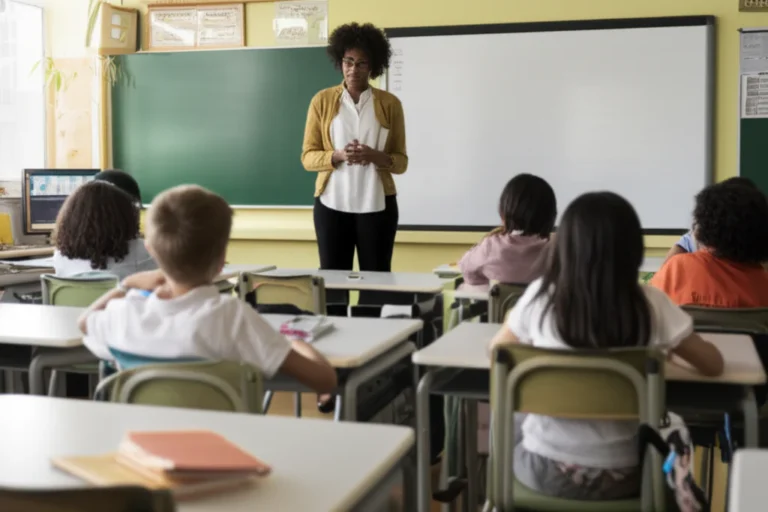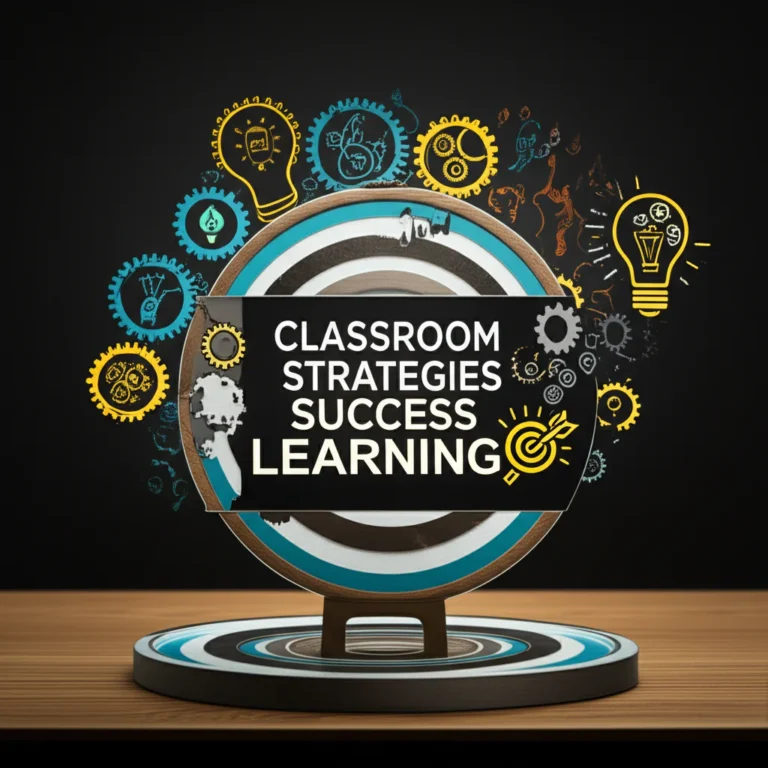Support our educational content for free when you buy through links on our site. Learn more
6 Must-Have Teacher Management Techniques for Classroom Success (2025) 🎓
Picture this: you walk into your classroom on day one, buzzing with excitement, only to be met with chaos—students chatting loudly, desks askew, and a general sense of “anything goes.” Sound familiar? We’ve all been there. But what if you could flip that script and create a classroom environment so smooth and engaging that students practically police themselves? That’s the magic of mastering the right management techniques.
In this article, we’ll reveal the 6 essential management techniques every teacher should develop to transform your classroom into a thriving learning hub. From designing your space and setting rock-solid routines to nurturing emotional intelligence and leveraging tech tools, we cover it all. Plus, we’ll share insider tips from seasoned educators at Teacher Strategies™ and spotlight tools like ClassDojo and Prodigy that can make your life easier. Ready to unlock your classroom’s full potential? Let’s dive in!
Key Takeaways
- Proactive classroom design and clear routines lay the groundwork for smooth days and fewer disruptions.
- Building positive relationships and mastering communication foster trust and respect, reducing behavioral issues.
- Strategic behavior management focuses on guidance and positive reinforcement rather than punishment.
- Engaging instruction and differentiated learning keep students motivated and on task.
- Effective time management and pacing maximize instructional time and maintain student focus.
- Emotional intelligence and self-regulation support create a calm, empathetic classroom culture.
- Leveraging technology tools like ClassDojo and Prodigy enhances management and engagement.
👉 Shop Classroom Management Tools:
- ClassDojo: Amazon | ClassDojo Official
- Prodigy Math: Amazon | Prodigy Official
Table of Contents
- ⚡️ Quick Tips and Facts for Classroom Management Mastery
- 📚 The Unsung Hero: Why Classroom Management is the Foundation of Effective Teaching
- 🚀 Elevating Your Craft: The 6 Essential Management Techniques Every Teacher Needs to Master
- 🛠️ Technique 1: Proactive Classroom Design & Establishing Crystal-Clear Routines
- 🤝 Technique 2: Cultivating Positive Relationships & Mastering Communication Skills
- 🧠 Technique 3: Savvy Behavior Management & Strategic Intervention
- 💡 Technique 4: Igniting Engagement Through Dynamic Instruction & Differentiated Learning
- ⏰ Technique 5: The Art of Time Management & Seamless Pacing
- 🧘 Technique 6: Nurturing Emotional Intelligence & Self-Regulation for All
- 🌟 Beyond the Basics: The Profound Impact of Masterful Classroom Management on Student Success
- 🎯 Putting Theory into Practice: Real-World Application of Management Techniques
- 🚧 Navigating the Minefield: Common Classroom Management Pitfalls & How to Dodge Them
- 📱 Tech-Savvy Teaching: Leveraging Technology for Enhanced Classroom Control
- 🌍 Inclusive Classrooms: Differentiated Management for Diverse Learners (ELLs, Special Needs, & More!)
- 🏡 Partnering for Success: Engaging Parents in Your Classroom Management Strategy
- 💖 Teacher Well-being: Self-Care Strategies for Sustainable Classroom Leadership
- ✅ Conclusion: Your Journey to Classroom Management Mastery
- 🔗 Recommended Resources & Tools for Educators
- ❓ Frequently Asked Questions About Classroom Management
- 📚 Reference Links & Further Reading
⚡️ Quick Tips and Facts for Classroom Management Mastery
Welcome to your crash course in the art and science of classroom management! 🎓 At Teacher Strategies™, we’ve distilled decades of combined teaching wisdom into some quick-fire facts and tips that every educator should have in their toolkit:
- Clear expectations = fewer disruptions. Students thrive when they know the rules upfront. (Source: Schools That Lead)
- Relationships matter. Genuine connections with students reduce behavioral issues and boost engagement.
- Positive reinforcement works wonders. Specific praise and rewards encourage repeat good behavior.
- Routines are your best friend. Predictability creates a safe learning environment.
- Move with purpose. Proximity control is a subtle but powerful way to keep students on task.
- Consistency builds trust. Fair discipline policies help students feel secure.
💡 Did you know? Teachers who implement these strategies report less stress and more classroom harmony. But how do you weave these into your daily teaching? Keep reading! For a deep dive into teaching strategies, check out our article on What are the 6 key teaching strategies?
📚 The Unsung Hero: Why Classroom Management is the Foundation of Effective Teaching
Imagine trying to conduct a symphony with half the orchestra out of tune and timing. That’s what teaching without solid classroom management feels like. It’s the foundation upon which all learning is built.
Why does classroom management matter so much?
- Creates a positive culture: When students know what’s expected, they feel safe and respected.
- Maximizes instructional time: Less time spent on discipline means more time for learning.
- Improves student outcomes: Studies show better behavior correlates with higher academic achievement (Edutopia).
- Reduces teacher burnout: Managing chaos is exhausting. Effective strategies reduce stress and increase job satisfaction.
At Teacher Strategies™, we’ve seen firsthand how classrooms transform when teachers master management. It’s not just about control — it’s about building community and fostering growth.
🚀 Elevating Your Craft: The 6 Essential Management Techniques Every Teacher Needs to Master
Ready to level up your classroom mojo? Here are the six powerhouse techniques every teacher should develop to create a thriving learning environment. We’ll unpack each in detail below!
1. 🛠️ Technique 1: Proactive Classroom Design & Establishing Crystal-Clear Routines
Step 1: Design your space for success.
Think of your classroom as a stage. The layout should minimize distractions, allow smooth movement, and foster collaboration. For example, flexible seating options like those from Steelcase or KI Furniture can help create zones for quiet work and group activities.
Step 2: Set routines that stick.
From morning entry to transitions and cleanup, routines provide predictability. Post visual schedules and practice routines with students regularly. This reduces anxiety and off-task behavior.
| Routine Element | Why It Matters | Pro Tip |
|---|---|---|
| Morning Entry | Sets tone for the day | Greet students individually |
| Transition Procedures | Minimizes downtime and chaos | Use timers or signals |
| Cleanup Time | Encourages responsibility | Assign classroom jobs |
Our Educator Insight: One of our veteran teachers swears by a “soft start” routine — allowing students 5 minutes of quiet reading or journaling as they settle in. It sets a calm tone and eases energy spikes.
2. 🤝 Technique 2: Cultivating Positive Relationships & Mastering Communication Skills
Why relationships trump rules every time: Students who feel known and valued are more likely to follow expectations. This means investing time in learning about their interests, cultures, and challenges.
Communication hacks:
- Use active listening: Reflect back what students say to show understanding.
- Employ non-verbal cues: Eye contact, nodding, and open body language build trust.
- Be clear and consistent with instructions and feedback.
Real Talk: One of our team members shared how greeting students by name every morning transformed classroom dynamics. “It’s a small gesture but it says, ‘You matter here.’”
3. 🧠 Technique 3: Savvy Behavior Management & Strategic Intervention
Managing behavior isn’t about punishment — it’s about guiding students towards self-regulation.
Key strategies:
- Set clear, fair consequences and communicate them upfront.
- Use positive reinforcement like praise, points, or tangible rewards.
- Apply proximity control: moving closer to off-task students can redirect behavior without confrontation.
- Address issues privately to preserve dignity.
- Implement restorative practices to repair harm and rebuild relationships.
Did you know? According to Schools That Lead, “praise publicly, correct privately” is a golden rule that fosters respect.
4. 💡 Technique 4: Igniting Engagement Through Dynamic Instruction & Differentiated Learning
Engaged students are well-behaved students. Keeping learners hooked requires dynamic teaching and meeting diverse needs.
How to engage:
- Use varied instructional strategies like group work, hands-on activities, and technology integration (Instructional Strategies).
- Differentiate content, process, and product based on student readiness and interests (Differentiated Instruction).
- Incorporate student choice to boost ownership.
Tech Tools: Platforms like Prodigy Math adapt to student skill levels and keep learning fun and personalized (Prodigy Math on Amazon).
5. ⏰ Technique 5: The Art of Time Management & Seamless Pacing
Time is your most precious resource. Mastering pacing keeps lessons flowing and students attentive.
Tips for timing mastery:
- Plan lessons with built-in buffer time for transitions and unexpected questions.
- Use timers and signals to keep students aware of pacing.
- Break lessons into manageable chunks with varied activities.
- Monitor student engagement and adjust pace accordingly.
Teacher Tip: One of our educators uses a simple kitchen timer app to signal transitions — students respond better to visual and auditory cues than verbal commands alone.
6. 🧘 Technique 6: Nurturing Emotional Intelligence & Self-Regulation for All
Classrooms are emotional ecosystems. Helping students develop emotional intelligence (EQ) leads to better behavior and academic success.
Strategies to foster EQ:
- Teach mindfulness and breathing exercises to manage stress.
- Use social-emotional learning (SEL) curricula like Second Step or CASEL frameworks.
- Model calm responses and empathy.
- Encourage students to reflect on feelings and behavior.
Our Experience: Incorporating a 5-minute mindfulness break mid-lesson has helped many teachers reduce disruptions and improve focus.
🌟 Beyond the Basics: The Profound Impact of Masterful Classroom Management on Student Success
When classroom management is done right, the ripple effects are incredible:
- Higher academic achievement: Students spend more time learning and less time off-task.
- Improved attendance: A positive environment encourages students to show up.
- Better social skills: Students learn respect, cooperation, and conflict resolution.
- Teacher satisfaction: Less stress, more joy in teaching.
According to Prodigy Game’s research, effective management reduces teacher burnout and improves student outcomes — a win-win!
🎯 Putting Theory into Practice: Real-World Application of Management Techniques
Theory is great, but what about the nitty-gritty of daily teaching? Here’s how to bring these techniques alive:
- Start the year with a classroom meeting to co-create rules and routines.
- Use visual aids like posters and charts to reinforce expectations.
- Practice transitions explicitly during the first weeks.
- Incorporate technology like ClassDojo for behavior tracking and parent communication.
- Reflect weekly on what’s working and adjust strategies.
A Teacher’s Story: Ms. Ramirez shared how involving students in rule-making increased ownership and reduced disruptions dramatically. “They police themselves now — it’s magic!”
🚧 Navigating the Minefield: Common Classroom Management Pitfalls & How to Dodge Them
Even the best teachers stumble. Here are common traps and how to avoid them:
| Pitfall | Why It Happens | How to Avoid |
|---|---|---|
| Inconsistent enforcement | Fatigue or uncertainty | Stick to rules; use a behavior plan |
| Over-reliance on punishment | Quick fix temptation | Focus on positive reinforcement |
| Ignoring student voice | Lack of time or confidence | Involve students in decisions |
| Neglecting self-care | Teacher burnout | Prioritize well-being and breaks |
| Overcrowded classrooms | Systemic issue | Use grouping and tech to differentiate |
Remember, flexibility and reflection are your allies. Classroom management is a journey, not a destination.
📱 Tech-Savvy Teaching: Leveraging Technology for Enhanced Classroom Control
Technology isn’t just a distraction — it can be a classroom management superhero! Here’s how:
- Behavior tracking apps: ClassDojo, Kickboard, and Hero let you monitor and reward behavior in real time.
- Timers and signals: Apps like Time Timer help manage transitions smoothly.
- Adaptive learning platforms: Prodigy Math and Khan Academy personalize learning to keep students engaged.
- Communication tools: Remind and Bloomz facilitate parent-teacher communication, reinforcing expectations at home.
Teacher Strategies™ Tip: Use tech purposefully — don’t let it become a crutch or distraction. Blend it with face-to-face interactions for best results.
👉 Shop Classroom Tech on:
- ClassDojo: Amazon | ClassDojo Official
- Time Timer: Amazon | Time Timer Official
🌍 Inclusive Classrooms: Differentiated Management for Diverse Learners (ELLs, Special Needs, & More!)
Diversity is the spice of life — and classrooms! Managing a room with English Language Learners (ELLs), students with special needs, and varied backgrounds requires extra finesse.
Strategies for inclusivity:
- Culturally responsive teaching: Incorporate students’ cultures and languages into lessons (Edutopia).
- Language supports: Use visuals, sentence frames, and native language resources.
- Flexible grouping: Pair students strategically for peer support.
- Individualized behavior plans: Tailor interventions to student needs.
- Professional collaboration: Work with special educators and ESL specialists.
Our Educator’s Tip: One teacher uses the “preview, view, review” method — previewing content in students’ native languages, teaching in English, then reviewing to reinforce understanding.
🏡 Partnering for Success: Engaging Parents in Your Classroom Management Strategy
Parents are your secret weapon in classroom management. When they’re on board, students get consistent messages and support.
How to build partnerships:
- Communicate regularly and positively via newsletters, apps, or calls.
- Share classroom expectations and routines early.
- Invite parents to participate in school events and volunteer.
- Provide resources and tips for supporting learning at home.
- Celebrate student successes with positive phone calls or notes.
Pro Tip: Use apps like Remind or Bloomz to send quick updates and positive feedback.
💖 Teacher Well-being: Self-Care Strategies for Sustainable Classroom Leadership
You can’t pour from an empty cup! Managing a classroom takes energy and emotional resilience.
Self-care essentials:
- Set boundaries to protect personal time.
- Practice mindfulness or meditation.
- Connect with colleagues for support and collaboration.
- Take regular breaks during the day.
- Engage in professional development to boost confidence and skills (Instructional Coaching).
Our Team’s Experience: Teachers who prioritize well-being report better classroom control and job satisfaction. It’s not selfish — it’s smart!
✅ Conclusion: Your Journey to Classroom Management Mastery
So, what have we uncovered on this whirlwind tour of classroom management? From proactive classroom design to nurturing emotional intelligence, these six essential techniques form the backbone of a thriving, well-run classroom. When you combine clear expectations, positive relationships, strategic behavior management, engaging instruction, savvy time management, and emotional support, you’re not just managing a room — you’re cultivating a community.
Remember the question we teased earlier: How do you weave these strategies into your daily teaching? The answer is simple but profound — start small, be consistent, and reflect often. Try one technique at a time, observe the impact, and adjust. Over time, these strategies become second nature, transforming your classroom into a place where students feel safe, engaged, and empowered.
And if you’re wondering about technology’s role, tools like Prodigy Math and ClassDojo can be powerful allies — but only when used thoughtfully alongside your personal touch.
At Teacher Strategies™, we confidently recommend embracing these techniques as your foundation. They’re backed by research, proven in classrooms worldwide, and supported by our own teaching experiences. Your classroom management journey is a marathon, not a sprint — but with these strategies, you’re well-equipped to cross the finish line with flying colors! 🎉
🔗 Recommended Resources & Tools for Educators
Ready to equip your classroom with the best tools and resources? Check out these top picks:
- Prodigy Math:
- ClassDojo:
- Time Timer:
- Second Step SEL Curriculum:
- Books for Deeper Learning:
❓ Frequently Asked Questions About Classroom Management
What are the most effective classroom management strategies for new teachers?
For new teachers, establishing clear expectations and routines is paramount. This sets the tone and reduces confusion. Building positive relationships early on fosters trust and cooperation. Using positive reinforcement encourages desired behaviors, while consistent and fair consequences help maintain order. Starting with these basics creates a stable environment where learning can flourish.
Additionally, new teachers should seek mentorship and professional development opportunities focused on classroom management to build confidence and skills. Remember, mastery comes with experience and reflection.
How can a teacher create a positive and respectful learning environment for their students?
Creating a positive environment hinges on respect, inclusivity, and connection. Teachers should show genuine interest in students’ lives and cultures, incorporate culturally responsive teaching, and encourage student voice. Clear communication of expectations, consistent routines, and fair discipline contribute to a safe space.
Using social-emotional learning (SEL) practices helps students develop empathy and self-regulation, which enhances respect among peers. Celebrating successes publicly and addressing issues privately also nurtures a supportive atmosphere.
What role does communication play in successful classroom management and teacher-student relationships?
Communication is the lifeblood of classroom management. Clear, consistent, and respectful communication sets expectations and builds trust. Active listening and non-verbal cues demonstrate empathy and understanding, which deepen relationships.
Effective communication also involves feedback loops — providing specific praise and constructive guidance helps students understand how to improve. Engaging parents through communication platforms like Remind or Bloomz extends support beyond the classroom walls.
What are some common classroom management challenges that teachers face, and how can they be overcome?
Common challenges include inconsistent enforcement of rules, over-reliance on punishment, student disengagement, and teacher burnout. Overcrowded classrooms and diverse learner needs add complexity.
To overcome these:
- Maintain consistency and fairness in rule enforcement.
- Focus on positive reinforcement rather than punishment.
- Employ engaging instructional strategies and differentiate learning.
- Prioritize teacher well-being through self-care and professional support.
- Use technology and collaboration to manage diverse needs effectively.
Reflection and adaptability are key — no one-size-fits-all solution exists, but a flexible mindset helps teachers navigate challenges successfully.
How can technology be integrated effectively into classroom management without becoming a distraction?
Technology should be used purposefully to enhance engagement and streamline management tasks. Behavior tracking apps like ClassDojo provide real-time feedback, while timers help with transitions. Adaptive platforms like Prodigy Math personalize learning, reducing off-task behavior.
However, it’s crucial to set clear guidelines for tech use, balance screen time with offline activities, and maintain face-to-face interactions. Technology is a tool, not a replacement for strong teacher presence.
📚 Reference Links & Further Reading
- Schools That Lead: Best Classroom Management Strategies
- Prodigy Game: Classroom Management Strategies
- Edutopia: 6 Essential Strategies for Teaching English Language Learners
- ClassDojo Official Website
- Prodigy Official Website
- Time Timer Official Website
- Second Step SEL Curriculum
- Teacher Strategies™ Instructional Strategies
- Teacher Strategies™ Lesson Planning
- Teacher Strategies™ Classroom Management
- Teacher Strategies™ Differentiated Instruction
- Teacher Strategies™ Instructional Coaching
Ready to transform your classroom? Dive into these strategies, tools, and resources — your students (and your future self) will thank you! 🎉





